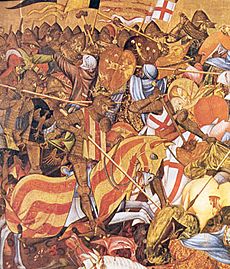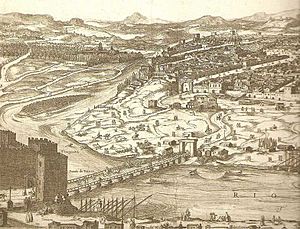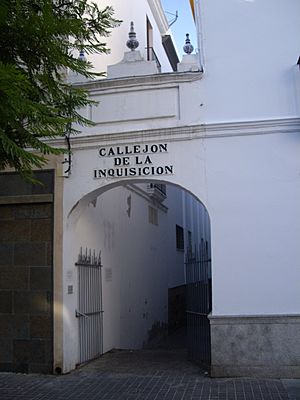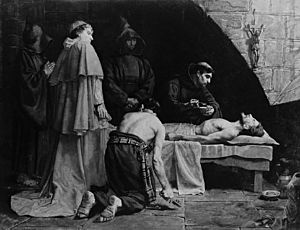Castle of San Jorge facts for kids
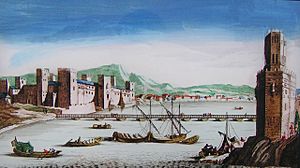
The Castle of San Jorge was a very old fortress built next to the Guadalquivir river in Seville, Spain. It was also used as the main office and prison for the Spanish Inquisition.
The castle was taken down in the 1800s. A food market was built in its place. Today, you can visit a museum underground. It shows the castle's history, the Spanish Inquisition, and how people faced religious challenges. Near the market in the Triana neighborhood, a path called the Alley of the Inquisition still connects two streets. This path was once part of the castle's walls.
Contents
History of the Castle
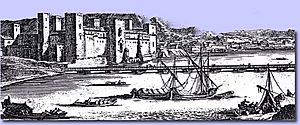
Long ago, the Visigoths built a fort here. It helped protect their city, which they called Spalis (now Seville).
Later, in 1171, during the time of the Almohad rulers, King Jucef Abu Jacub ordered a special bridge to be built. It was called the Bridge of Boats. This floating bridge connected the two sides of the river. It was held in place by chains linked to the castle, which was then known as the Castle of Gabir.
The king also brought water from the Guadalquivir river into the city. He spent a lot of money on this project. He also ordered the building of the Alcazar palace and the fortress of Alcalá de Guadaíra. King Jucef Abu Jacub died in 1184 during a battle.
Years later, Ferdinand III of Castile wanted to take Seville. His fleet, led by Ramón de Bonifaz, broke the chains of the Bridge of Boats. This helped Ferdinand III capture the city in 1248. After this, the castle belonged to the Military Order of Saint George of Alfama until 1280. This order was for knights and soldiers.
From Triana Castle to San Jorge Castle
In 1246, Seville and Granada were the last big cities in Spain not under Christian rule. In 1247, Christian armies surrounded Seville. The siege began when Ramón de Bonifaz sailed up the Guadalquivir river with his ships. On May 3, the Castilian fleet broke the bridge that connected Seville and Triana.
Because of a severe lack of food, the Muslim rulers had to surrender. The city gave up on November 23, 1248. They agreed to King Ferdinand III's terms. These terms said they had to leave the city completely. Castilian troops would enter the alcázar (fortress) within a month. During this time, the city was prepared for the new rulers. Mosques were cleaned to become Christian churches. The best houses were saved for the new leaders.

After this, the Moorish king Axataf gave the city keys to King Ferdinand. The city was empty for three days. King Ferdinand made his grand entry into Seville on December 22, 1248.
After taking the city, everything was divided up according to Castilian laws. A conquered city belonged to the conqueror. The land and houses were given to the royal family, knights, bishops, and soldiers. Everyone who helped in the victory received something.
The Order of St. George of Alfama received the Castle of Triana. Triana was called "Guarda de Sevilla," meaning "Guardian of Seville."
The Order of St. George was different from other military orders. Its main goal was to protect the coast from invaders and help people settle new areas. The king believed that guarding the riverbanks of the Guadalquivir fit their mission. So, he gave them the castle, and it was renamed the Castle of San Jorge (Saint George).
Inside the castle, the knights honored their patron, Saint George. They held religious ceremonies in a chapel. Over time, this chapel became the first church of Triana. This is why people in Triana have a special devotion to Saint George.
However, people in the 1200s did not see this Order as very important. Other military orders were more famous. So, the Order of St. George of Alfama lived a quiet life for over a hundred years.
Even though their knights were brave in war, they lived a relaxed life during peaceful times. In 1400, the Order of St. George of Alfama joined with the powerful Order of Montesa and disappeared.
Because of this, and because the castle became less important for defense, the Castle of San Jorge was neglected in the late 1400s.
In 1481, the abandoned castle was given to the newly formed Inquisition. They used it as their main office and a prison.
Headquarters of the Inquisition Court
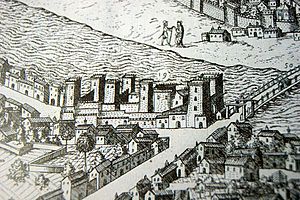
When the Inquisition started in Seville, they needed more space for their prisoners. The Castle of San Jorge was empty, so it was given to them.
The Inquisition was created by the Catholic Monarchs. It began operating in Seville in 1481. Its main goal was to investigate and prosecute people accused of not truly following the Catholic faith. It was an independent institution, separate from the Church.
Seville was a city with many different cultures. It had large Jewish and Moorish communities. It was also a big trading center, open to people from all nations. This made it a place where different ideas could spread.
The Inquisition's main work was to pursue and prosecute those accused of being false converts.
The Castle of San Jorge was where prisoners were held. It was where the court conducted its "interrogations." Prisoners waited there for their sentences. The jail cells were often unhealthy, either too wet or too hot.
The Castle of San Jorge was a place that many people feared. This was partly because some criminals who were friends or relatives of the Inquisition were said to have special protection there.
The Inquisition also had helpers called "familiars." These were like police who had special rights. They could carry weapons and were not judged by other courts.
Public ceremonies where sentences were announced, called Auto-da-fés, took place in Seville. They were held first at the Cathedral steps, then in the Plaza de San Francisco, and also in the Church of Santa Ana. Many people would gather to watch these ceremonies.
The Florentine artist Pietro Torrigiano was arrested by the Inquisition. He died in the Castle of San Jorge in 1522. Some say he died during a hunger strike.
The Inquisition left the castle in 1626 because its walls were damaged by floods. After that, it was given to the Count-Duke of Olivares. He was in charge of its repairs and care.
Later, the castle was given to the city. The City Hall decided to tear it down in the 1800s. This was done to make more space and build a grain warehouse.
Around 1830, a food market was built on the site. This market is still there today. The Alley of the Inquisition, which was part of the old castle, reminds people of the Inquisition's presence in Triana.
The Castle Today
In 1823, the Triana Market was built where the castle once stood. This market is still busy today. Many archaeological digs have taken place under the market. These digs found old remains that are now part of a museum. In 2009, the City Hall of Seville opened the Castillo de San Jorge project. It is a center that explains the castle's ruins and the history of the Spanish Inquisition.
The Castle in Beethoven's Opera Fidelio
In 1805, the famous composer Ludwig van Beethoven presented his opera Fidelio. This opera is about a prison in Seville that held prisoners of conscience in the late 1700s. While Beethoven did not name the prison specifically, it is very likely he was thinking of the Castle of San Jorge.
In recent years, Seville has tried to highlight its connection to opera. They have an initiative called "Seville City of Opera." This includes tours of the castle that talk about Seville's opera history. A special plaque has also been placed at the site to remember this connection.
See also
 In Spanish: Castillo de San Jorge (Sevilla) para niños
In Spanish: Castillo de San Jorge (Sevilla) para niños


